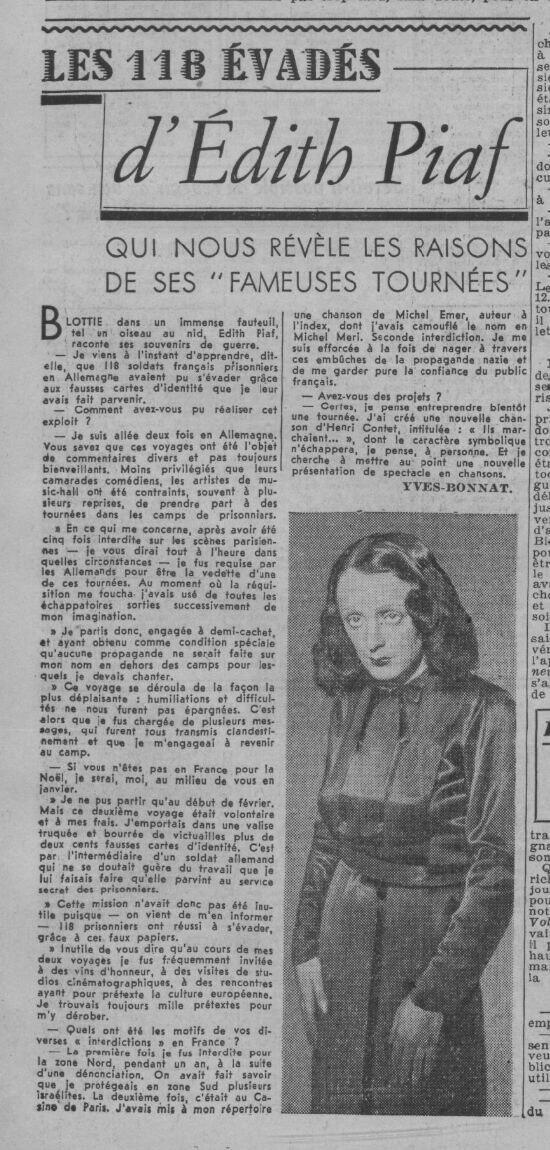If this were a Hollywood script, it would likely be dismissed as too far-fetched. Three women—neither underground fighters nor spies—chose to risk their lives to save Jews during World War II. Through acts of forging passports, daring smuggling operations, hiding people in grand palaces, and assuming false identities, these women took extraordinary measures to rescue Jewish souls from the clutches of destruction during one of humanity's darkest periods.
Now, thanks to Holocaust researcher Meir Bulka, the rescue story of Edith Piaf, Andrée Bigard and Lily Pastré—three brave women whose heroic deeds were nearly forgotten for decades—is finally coming to light.
At the heart of this trio is none other than Edith Piaf, one of the most iconic voices of France and international music history. Known for her deeply emotive and haunting songs, Piaf used her freedom of movement and connections with influential figures to save Jews.
One particularly dramatic account reveals how she agreed to perform for French prisoners of war held in Germany—on the condition that she could have her photo taken with them. These photos were smuggled back to France, where they were used to create forged identity documents. These counterfeit papers aided in the escape of up to 200 prisoners, many of whom were Jewish.
According to testimonies, Piaf also sheltered Jewish artists, helped produce forged documents for them, and facilitated their escape with the help of her personal assistant, Andrée Bigard. Among those rescued were Norbert Glanzberg, a gifted Jewish composer who was also Piaf's romantic partner for a time; Michel Emer (Emer Rosenstein), a Jewish musician whose songs were performed by Piaf and Yves Montand; Clara Haskil, a Romanian-born Jewish pianist specializing in classical music; the director Marcel Bluwal; and the Jewish pianist Yura Guller, who had come to Paris after spending years in China. Guller was forced to live much of her life in hiding, using a false identity provided by Piaf and Bigard.
Andrée Bigard, Piaf's personal assistant, played a critical role in these rescue efforts. Bigard harbored Glanzberg in her home for six months, putting her own life and her family’s lives at great risk. She was a full partner in these operations, which included forging passports and assisting in the escape of prisoners from France to Germany.
The third heroine is Countess Lily Pastré, an aristocrat from southern France who turned her palace into a sanctuary for Jewish musicians. Piaf herself ensured that these musicians were presented as her accompanying performers in concerts—even when some audience members were German SS officers. Piaf was accused of collaborating with the Nazis and even met with Nazi propaganda minister Joseph Goebbels. However, after the war, she was cleared of these allegations, as her actions were revealed to have been clever maneuvers aimed at helping French prisoners.
Despite the magnitude of their heroism, Piaf, Bigard nor Pastré have not been officially recognized as Righteous Among the Nations. In July 2024, Meir Bulka submitted a comprehensive dossier to Yad Vashem, including quotes from Piaf's biography by author Carolyn Burke, a journalistic article from 1944, documentation from Piaf’s biographer David Looseley, and testimonies from the British press. However, the response he received was disheartening: without firsthand testimony, the recognition process cannot move forward.
“All the survivors are no longer alive,” Bulka laments. “But we have enough historical documentation—articles, books, and other records—to know that Piaf, Bigard and Pastré saved Jewish lives. It’s time to formally acknowledge this.”
Bulka, a senior researcher at Bar-Ilan University's Holocaust Research Institute and head of the JNERATIONS organization, has dedicated years to preserving Jewish memory. His work includes locating burial sites, synagogues, and the ruins of Jewish communities across Europe. He has spearheaded dozens of projects to commemorate Jewish history. For him, uncovering this story is part of a broader effort to restore honor to forgotten heroes. "I’m just dusting off the story,” he says. “These stories have been hiding in plain sight all along. It’s time to tell the truth—three women who weren’t fighters, weren’t members of the resistance, but were heroes in every sense of the word.”
Bulka notes that no survivors remain alive today to provide firsthand testimony. However, he mentions that Serge Glanzberg, the son of Norbert Glanzberg, is believed to hold significant testimony on the matter. Unfortunately, Serge has refused to share these materials, despite repeated efforts to gain access.
“All I can do is hope that Yad Vashem will show flexibility in its decision-making process and recognize that these three women saved Jews during the Holocaust, based on the evidence we’ve presented,” Bulka adds.
Yad Vashem responded: "The story in question is known and has been reviewed. To date, Yad Vashem has invested significant efforts in attempts to locate testimonies and archival documentation regarding the story, but none have been found or submitted that could assist in the recognition process for Piaf, Bigard and Pastré.
"The Commission for the Designation of the Righteous Among the Nations, the body responsible for granting this title, relies primarily on testimonies from the Jews who were helped, recorded from the end of the war to today. In recent years, approximately 200 individuals have been recognized annually, based on survivor testimonies in formats such as written memories, personal diaries, and more. The commission also considers independent sources, such as compensation requests, post-war legal documents, and other records that reference individuals who assisted Jews.
"As for the testimony of Norbert Glanzberg: as mentioned, it has not been submitted to Yad Vashem. If it is received, it may shed additional light on the activities of these three women. The Department for the Righteous Among the Nations responds to every inquiry and welcomes the submission of relevant materials to support the review of rescue stories. The same has been done in this case."



